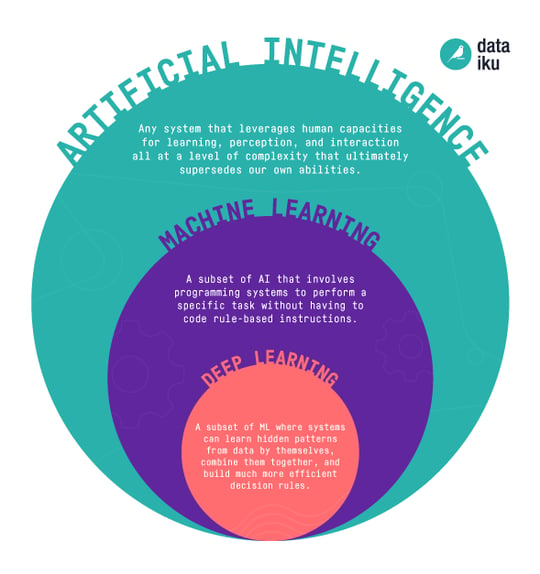Talking about AI is increasingly complex because it’s often used alongside (or even interchangeably with) the terms machine learning (ML) and deep learning (DL). Why do people use these terms relatively interchangeably, and what are the distinctions?
In a nutshell: DL is a subset of ML, which is itself a subset of AI (this graph helps explain this nuance):

And for an even deeper understanding, a little history.
From Business Rules to Machine Learning
Before the start of machine learning in the 80s, business decision rules were mostly hand-coded sets of instructions based on the knowledge of business experts. With machine learning, those rules are inferred from the previously collected data — the business expertise plays a role (and is in fact required) for the feature engineering part.
Basically, the business expert needs to determine which factors may impact the results you want to predict, and the algorithm automatically selects the optimal way to combine these factors. In other words, you ”train” a model. The key question is: based on my data, what is the best rule I can create to solve my business problem?
Now What Are the Specificities of Deep Learning?
A DL algorithm is able to learn hidden patterns from the data by itself, combine them together, and build much more efficient decision rules. That’s why it can deal with problems that a human brain could not understand — all the value of deep learning is this automatic pattern identification capability. This means handling more complex problems, such as understanding concepts in images, videos, texts, sounds, time series, and all other unstructured data you think of.
But don’t think deep learning as a model learning by itself. You still need properly labeled data, an evaluation of the model results, and of course an evaluation of the business value it will bring! Actually, the lack of precisely labeled data is one of the main reasons DL can have disappointing results in some business cases.
Of course handling more complex data means more complex algorithms. And to extract general enough complex patterns from complex data, you will need lots — read LOTS — of examples (much more than an ML model) — typically millions of labeled images for a classification task.
Since the feature engineering is automatically done by the machine, the interpretation is not obvious for a human and DL “black-box” decision rules can be rejected by business analysts. In fact, DL model interpretability is one of today’s biggest DL research challenges.
ML vs. DL
That means don’t throw all your classical ML models out the window! In most classical data-related problems, ML approaches still do a better job than DL since they don’t involve unstructured data. For example, here’s a simple illustration: I want to go from Manhattan to Brooklyn/Boston/Paris: walk, car, train, plane?
It comes down to a simple compromise between cost and time spent (cost > model designing time, time spend > accuracy). Flying from Manhattan to Brooklyn is the equivalent of using a DL model for a “simple” problem (that is to say, it's not efficient at all).
Where AI and Data Science Fit In
What about AI then? Well… we don’t really know. Is it a fancier word for DL? Some claim they did AI in the 50s. But most of them have something to do with automation and developing computer systems that think or learn more like humans than like traditional machines. And if this is the case, then at the very least, deep learning is certainly a large step toward that goal.
AI is also complex to define because it can refer to consumer-facing AI (think self-driving cars or home gadgets), but also to Enterprise AI. Enterprise AI is the ability to embed AI methodology into the very core of an organization’s business practices as well as into its data governance strategy. This means augmenting the work of people across all teams and disciplines with AI for more innovative operations, processes, products, and more.
When it comes to defining data science, which is frequently lumped together with machine learning, it is described as a field that uses processes, scientific methodologies, algorithms, and systems to gain knowledge and insights across structured and unstructured data. Moreover, data science definitions vary widely based on business function and role — different people across an organization might have bespoke definitions for what makes good data science. For data leaders, it might be tangible business impact, while for people like data scientists or engineers, it might be more detailed and nuanced — like the quality or accuracy of the model.
Whether we are defining data science, AI, machine learning, or deep learning, a common thread is that each of the four segments should be human driven. This human-in-the-loop intelligence is the key to truly responsible and transparent AI. Although Enterprise AI is at peak hype, bringing attention and enthusiasm to the data science space, it is important for organizations to educate themselves and built a responsible mission and vision for the implementation of AI in order to have a semblance of true impact.




